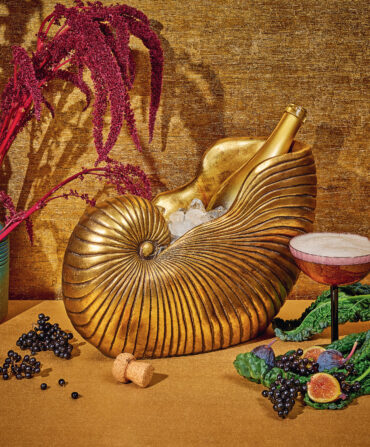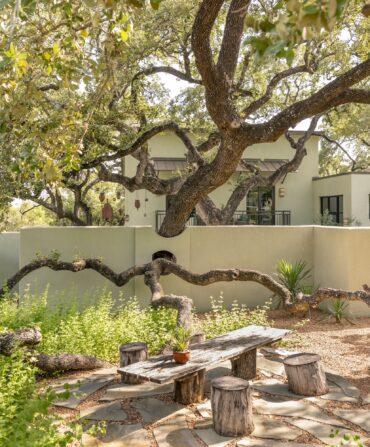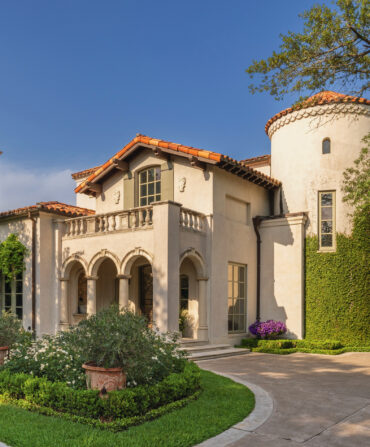Entertaining
The Art of Living
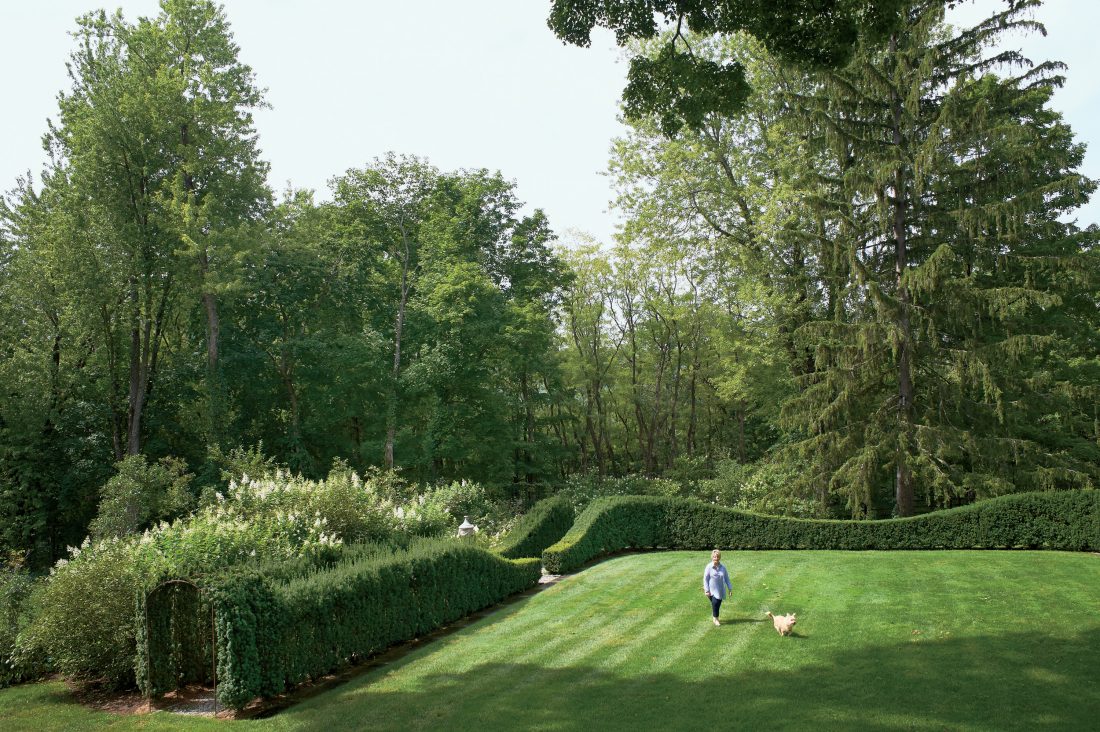
Photo: William Waldron
Almost every time I’ve arranged to meet with Bunny Williams, I’ve been horribly late (and not just a little embarrassed), but Bunny herself has never been anything but unfailingly gracious. When we were collaborating on a book about the houses of Furlow Gatewood, the inveterate collector who is her great friend, I not only forgot about the time difference between my house and Furlow’s (where we were spending the weekend), I got almost irretrievably lost (apparently Shangri-la doesn’t turn up on your average GPS). When I finally arrived, complete with beagle in tow (Bunny is forever exhorting folks to bring their pups to her houses and those of her friends), whiskey and cheese straws were immediately on offer, and everyone (including Bunny’s husband, John Rosselli, the über–antiques dealer who has also been Furlow’s business partner for decades) acted as though they always ate dinner at 11:00 p.m. Fast-forward a few years to this summer, when, stuck in Friday traffic between JFK and Bunny’s Connecticut retreat, I managed to delay yet another lovely meal. Again, I was welcomed effusively with a glass of rosé and a seat on the screened porch overlooking one of Bunny’s gorgeous gardens. After a perfect lunch of sliced tomatoes, fresh corn off the cob, and a new chicken salad John had spotted in the New York Times, we polished off the wine and tucked into homemade ice cream with peaches and cookies warm from the oven.
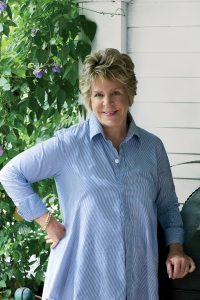
Photo: William Waldron
Williams, ready for guests.
Both times they’d been expecting me, of course, but the thing about Bunny is that she’s almost always expecting someone—and she’s prepared even if she’s not, a habit she credits to her upbringing in Charlottesville, Virginia. “I always say that in the South, people drop by,” she says. “You better have the bar set up and the olives out and the cheese straws and pecans ready.” The Southerners she grew up around were definitely house proud, she adds, “but they also cared about the way they lived. They cared about people and making them feel at home. This was something that was instilled in us.”
It’s this same talent for making people feel at home, for making them comfortable in their own spaces, that has most informed her work as an adult and made her one of the most well-known and respected interior designers in the world. In the course of her forty-year-plus career, which began at the legendary Manhattan firm Parish-Hadley, she has decorated houses in places as far-flung as the South of France and Sun Valley, Idaho. More important, she has taught her clients how to live in them.
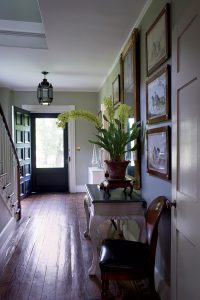
Photo: William Waldron
Open-Door Policy
The entry hall to the main house.
“She has such emotion and a genuine enthusiasm for helping people make houses that are nice for their guests and perfect for themselves,” says the designer Thomas Jayne, who first met Bunny when he joined Parish-Hadley as an assistant. “She’s totally intuitive.” But she works hard at it too, asking clients about everything from their TV-watching habits to whether or not they prefer to go barefoot indoors. “I have to understand how clients see themselves,” she says. “I want to create rooms to be used, not showcases to be admired. When people come over, they shouldn’t be intimidated by the house or the room or anything in it. Those who are interested may notice a good piece of furniture or a painting, but for people who are not interested, their feeling should be ‘This is a comfortable place to be.’” Above all, she says, she thinks about real life and the grace notes that make it easier. “It’s not just that you artfully place the chair in the corner of the room, which may look great for a photo shoot. But if you sit there, where are you going to put your drink?”
Her own houses, which have been well documented, are consummate testaments to her ethos. Her best-selling An Affair with a House (2005) is a fond account of how she transformed a well worn eighteenth-century Federal manor house in rural Connecticut into a glorious weekend home—with a series of stunning gardens, a much-used barn for entertaining, and an Adirondack-style pool house modeled after a Greek temple.

Photo: William Waldron
The main residence on the grounds was built in 1840 and is the subject.
Her most recent tome, A House by the Sea, was published in September and is a love letter to La Colina, the colonial villa she and John built from scratch in Punta Cana, a seaside community in the Dominican Republic, and modeled, she says, “on the houses of the Mississippi Delta, a style of architecture we both adore.” Though the books could certainly serve as manuals for fine decoration, the houses on view are clearly backdrops for guests and dogs and lots of dinners staged in multiple venues around the two properties. Photos might show perfectly scaled rooms and skillfully arranged collections of everything from blue-and-white porcelain to botanical prints, but there are also shots of a casually dressed Bunny setting one of her famous tables and of John napping on one of La Colina’s commodious porches. And everywhere there are the dogs, which currently include two rescue mutts in Connecticut and four in Punta Cana. “While I surround myself with lovely things, they never get in the way of living or make any room off-limits to my beloved dogs,” Bunny says. “I am always slightly suspicious of people who don’t like dogs in the house.”
Bunny’s love of dogs, like her knack for welcoming guests and passion for classical architecture, comes from her childhood. Her father, a horse breeder who was the head of the American Horse Show Association (now the United States Equestrian Federation), was a beautiful rider who often hunted with his pack of beagles. Bunny, who failed to inherit his ease in the saddle, preferred dressing up the dogs in her dolls’ clothes and pushing them around their two-hundred-acre property in a buggy. Her mother, says Bunny, was an amateur decorator with “great flair,” the person all her friends asked to help with their houses. “She was always fussing with things, going to auctions, having curtains made,” Bunny says. “I remember going with her to the curtain lady when I was maybe ten years old.” She also recalls—vividly—her family’s living room, a chic space featuring a tomato-soup-red-and-white plaid rug hand woven in North Carolina and beige toile curtains with a touch of red.
“For someone to have a cotton plaid rug in 1958, that was sort of out there,” Bunny says. “I could do that room today and it would be just fine.”
The house itself, a Georgian brick structure with a screened porch across the back, had an Oriental rug in the entrance hall that Bunny still puts to use. Like her own homes, it was also full of books and lots of china, which her mother collected. “I remember her blue lusterware tea service,” she says. “It was special, but we used it all the time.” The habit stayed with her, and now, possessed of countless sets of porcelain herself, she’s a big believer in people using their stuff, even (or perhaps especially) the good stuff, all the time. “Clients will say to me, ‘I need a coaster,’” she says, picking up a small porcelain dish on the table beside her. “This is my coaster! Buy a tea saucer for fifty dollars and put it on your table.”

Photo: William Waldron
A loggia off the carriage house.
In her teens she was sent to a strict boarding school where the students wore hats and gloves and where she was forever getting in trouble for such renegade acts as reading in her closet past lights-out and turning up late for class. “My father would come to take me home for vacation and I’d be walking off my demerits on the hockey field,” she says. Much as she disliked the “confinement” of school, she is grateful for the discipline. “The biggest gifts my parents gave me were manners and sociability.”
After graduating from boarding school, she begged to be allowed to attend Parsons School of Design, but her parents were horrified at the thought of their only daughter being on her own in Manhattan at such a young age. Instead, she went to a junior college in Boston that offered a two-year interior design program. When she finally landed in New York, she took a job at the noted antique dealer Stair & Co., where she did the cataloguing and “learned a tremendous amount.” She was also the receptionist, which meant she got to know the city’s most prominent decorators, including Sister Parish and Albert Hadley. When she was twenty-two, she was hired as Hadley’s secretary, an event she counts “as one of the luckiest” in her life. “I attended the University of Parish-Hadley,” she says. “I had the greatest education money cannot buy.”
From Parish, who came from a well-to-do family (and who, Bunny says, “was as Southern as anybody can be who wasn’t”), she learned the art of comfort. “She liked her chintz, she liked the cozy sofa, the nice lounge-y chair. She knew what made a room work.” If Parish was “the decorator,” Hadley, who grew up in Nashville, was “the designer,” Bunny says. “Albert knew more about the history of design than anybody I’ve ever met. He was adventuresome too, which she was not.” During her more than twenty years at the firm, Bunny absorbed their individual strengths (she credits Hadley for her ability to incorporate modern elements into her interiors) and learned invaluable lessons in volume and scale, which she worries are no longer taught. “If people don’t go look at rooms and measure them properly and figure out the proportion, it doesn’t work. Mrs. Parish could walk into a room, go off and buy a sideboard, and it would fit within four inches. So many rooms today look as though you went shopping first and then tried to make things fit.”
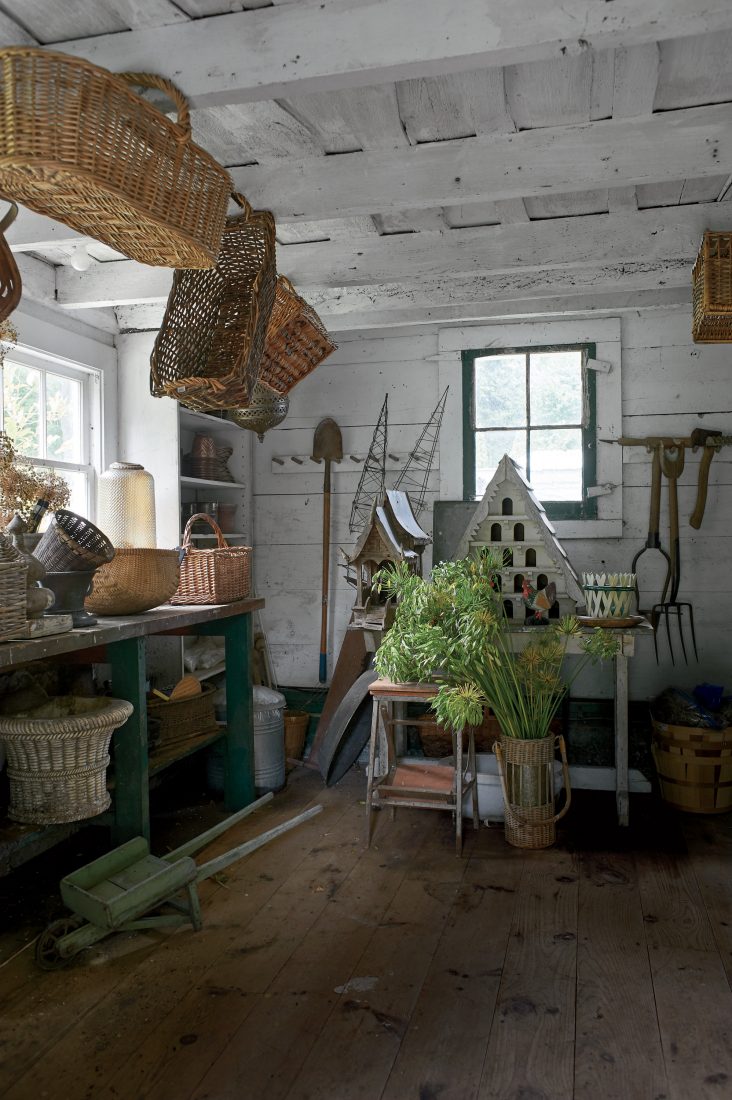
Photo: William Waldron
Baskets and birdhouses in the potting shed.
Another key part of her education came from exposure to the great homes of the firm’s illustrious clients: Bill and Babe Paley’s Fifth Avenue apartment; Jock and Betsey Whitney’s Long Island estate, Greentree. “We were exposed to the most extraordinary interiors that ever happened,” Bunny says, adding that at one point Hadley was asked to redo a whole wing at Greentree in preparation for a visit from Princess Margaret. On her own first visit to the Paleys’ apartment to drop off a package, the butler let Bunny come in and look around. “I saw my first real Picasso, all the Gauguins.” She drank it all in to the point “where I could still draw the floor plan to this day.”
In 1988, Bunny started her own firm, which now employs more than a dozen designers and assistants, and has been expanding her empire ever since. For twenty-five years, she and her husband owned Treillage Ltd., a much-loved decorative home and garden shop, and in 2008 she launched Bunny Williams Home, the furnishing collection that ranges from her signature “nail-head sofa” to cocktail tables and lamps. At an age when most designers would scale back (two years ago John threw a big bash to celebrate her seventieth birthday), she is busier than ever. “I call her the Energizer Bunny,” says Jayne, and he’s hardly the only one. Indeed, on the night before our lunch, she’d flown in from a site visit to an enormous mountain house she’s designing for clients in Idaho. After lunch, we toured the new—and very modern—two-story studio she’s just added to the grounds of the Connecticut property. It will house her archives and allow her more room to work when she’s not in Manhattan, where she keeps a spacious apartment and a design office in the same building in which John Rosselli Antiques is located. In the last two years, she has announced several partnerships, including one with Ballard Designs, the catalogue for which she creates affordable accessories based on her personal collections. (There’s a blue-and-white “Chinese” porcelain pet bowl, for example, along with bamboo tortoise flatware, and a salt-and-pepper cellar featuring a bird dog, a copy of a sterling silver one she owns.) In 2015 she launched her first-ever fabric line for Lee Jofa and opened a showroom in Manhattan’s Fine Arts Building to display the 150-plus designs for Bunny Williams Home in one place.
“I’m not saying I’m an artist, but a painter has to paint,” she says. “A musician has to play the piano. I have to do this. I love it. This is what I get up every day and want to do.” Even her downtime is full of activity. She putters in the garden or tweaks its design. She sets elaborate tables with the linens and glassware and china stored in her enormous butler’s pantries. She takes guests to tour other people’s gardens or nearby museums. “You have to stretch yourself. You have to look at new stuff.”
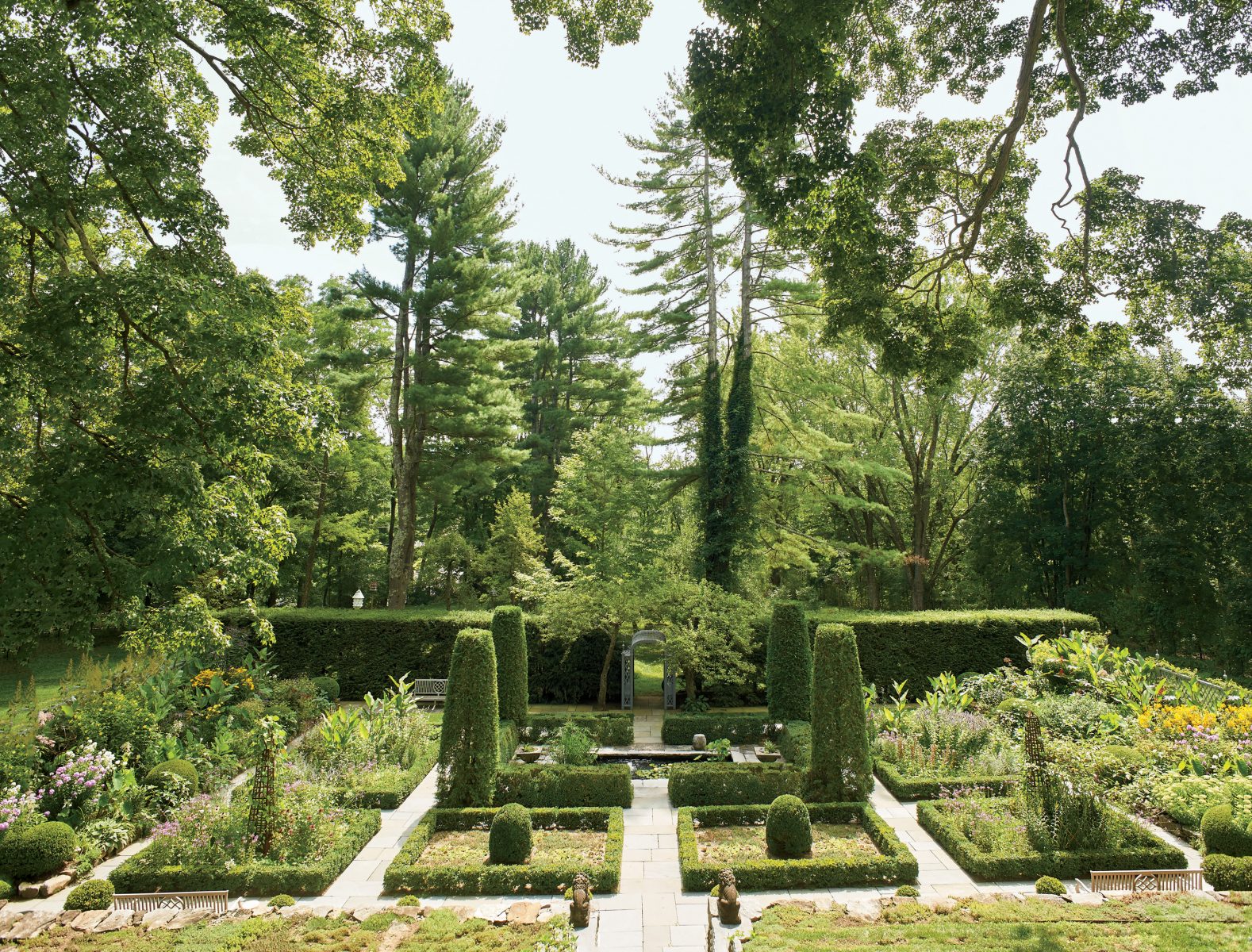
Photo: William Waldron
Beautiful by Design
The sunken garden, complete with a koi pond, is one of many outdoor refuges on the property.
All the things she’s amassed—from the soup tureens, salad crescents, and peach wedding-band china in one of the Connecticut closets to the seemingly endless collection of linens stacking the shelves in Punta Cana—are always put into service for others. “She works hard to have all this beauty,” says Howard Christian, the stylist and writer who managed Treillage for sixteen years. “She loves what she has, but more than that, she loves to share it.” He describes the many public garden tours she gives to benefit one cause or another: “You turn a corner and there’s a plate of cookies and a pitcher of lemonade so people can help themselves.” He laughs because he knows she can’t help it. “No matter who turns up, she is always ready. And she damn sure knows how to run a house. I have never slept so well in my life as I have in her guest rooms.”
The keeping and the sharing of the “stuff,” Bunny believes, is another deeply Southern trait. “You cared about the nice things you had and were taught to respect them,” she says, “because a lot of Southerners had them taken away.” She brings up the scene in Gone with the Wind when Scarlett has a dress made from Tara’s elaborate curtains, one of the few vestiges of its former glory. “When clients complain about the price of curtains, I say, ‘That’s your next evening gown.’”
It’s a funny line, and one indicative of Bunny’s down-to-earth sense of humor and utter lack of pretension. Her favorite hostess gift is a giant can of Hubs salted Virginia peanuts, and while at Furlow’s we made epic shopping trips to the nearby big-box store, where she stocked up on clothes and school supplies for the children of her Punta Cana employees. The generosity and grace of her interiors come from those same qualities in life. When Jayne first started at Parish-Hadley, his mother died, and “Bunny was right there,” he says. “She had no reason to look out for a needy assistant, but she does always step up.”
Clearly, she derives great joy from doing so. Every winter weekend in Punta Cana is a house party, and on the slower weekends in Connecticut, she is, again, ready. “Someone could walk in here right now and we could get dinner on the table,” she says. “There’s always something in the freezer, or John could make pasta. We just love doing that.” When the Wall Street Journal asked what she considered the “most fashionable place in the world,” she replied, “Wherever it may be, I don’t go there.” She meant, of course, that she’s not interested in trends, but she’d be crazy to depart from her own eminently stylish world, where dogs rule the roost and even the tardiest guest is embraced wholeheartedly.


